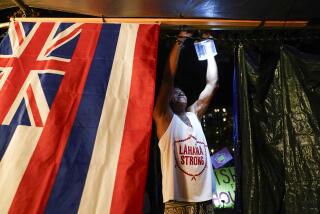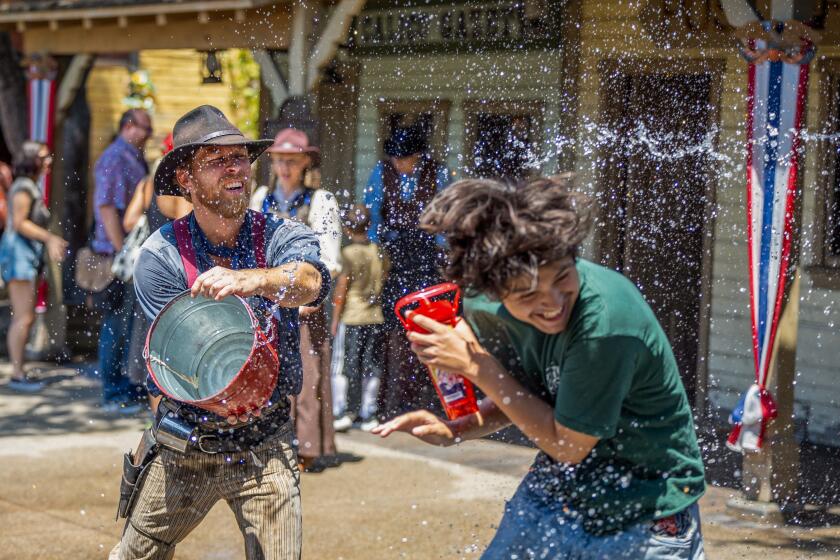2 major resorts on the Big Island still closed, 2 parks partly shut due to tsunami damage
At least two major resorts remained shuttered last week and at least two historic parks were partly closed on the island of Hawaii in the aftermath of the March 11 tsunami that damaged some hotels and beaches along the popular Kona and Kohala coasts on the island’s west side. But most businesses, hotels and attractions were open, according to the Big Island Visitors Bureau.
The popular 45-year-old Kona Village Resort, on the Kohala Coast, sustained extensive damage to its 82-acre beachfront site and will be closed indefinitely, spokeswoman Karine Joret said. The resort planned to lay off more than 200 employees next week, leaving only a small group to handle the shutdown. The resort’s future was unclear.
“We’re canceling all reservations, regardless of the time period,” Joret said. “There was pretty severe damage done to the resort. Over 20 bungalows were destroyed, as well as damage to our restaurants, gift shop, office and reception areas, bars and pools.” The resort has a total of 125 bungalows.
Some of the thatched-roof bungalows, known as hale, were lifted off their foundations by the water’s force. Sewer lines, electrical and other services were also affected, said Joret.
The luxury Four Seasons Resort Hualalai, in Kailua-Kona, will be closed until April 30 after sustaining damage from water, sand and debris that flowed onto the grounds. The surge affected mainly the pool areas, landscaping and a restaurant, plus 12 of the 243 guest rooms, the resort said in a statement. General manager Robert Whitfield said there was “no significant structural damage” but that the resort’s managers wanted to take time to “polish the property in the fashion it is known for.”
Guests with upcoming reservations were being contacted to make alternative arrangements, such as rebooking for a later date or staying at sister properties on the Hawaiian islands of Lanai and Maui, the resort said. Patrick Fitzerald, president and chief executive of Kona Village Resort and the Four Seasons Resort Hualalai, said damage to the two hotel properties is in the millions of dollars.
King Kamehameha’s Kona Beach Hotel in Kailua-Kona received damage to its first floor, but its guest rooms were not affected, said Deanna Isbister, director of sales. The Billfish Bar and the pool have been reopened, and the hotel resumed its Sunday luau, relocated to the garden area.
But much of the sand at Kamakahonu Beach, which fronts the hotel, was swept away, according to the Big Island Visitors Bureau. It was one of many beaches on the island’s western side that were pounded by the surges.
One of them was near the Waikoloa Beach Marriott Resort & Spa in Anaehoomalu Bay. The waves breached the beach, washing away a section and effectively separating the beach into north and south halves.
“A lot of the beaches along the Kona Coast were damaged,” said Eric Andersen, chief of interpretation for two national historic parks in the area.
Most of the 182-acre Puuhonua o Honaunau National Historical Park, about 20 miles south of the town of Kailua-Kona, remained closed as of early last week after tsunami-driven waves topped walls and pushed inland for hundreds of feet, carrying debris and vegetation, Andersen said.
The Royal Grounds, fish ponds, picnic area and the puuhonua (“place of refuge”) took the brunt of the damage, he added. The visitor center, amphitheater and paved parking lot were among areas that remained open from 9:30 a.m. to 4 p.m. daily.
No date had been set to reopen the park’s main areas.
“We’re going day by day, week by week, Andersen said.
The 1,161-acre Kaloko-Honokohau National Historical Park, about three miles north of Kailua-Kona, was open except for a small stretch of coastal trail. The park is known for its beaches and archaeological sites.
For updates on the situation in Japan, go to latimes.com and the U.S. State Department’s website for travelers at https://www.travel.state.gov.
More to Read
Sign up for The Wild
We’ll help you find the best places to hike, bike and run, as well as the perfect silent spots for meditation and yoga.
You may occasionally receive promotional content from the Los Angeles Times.






